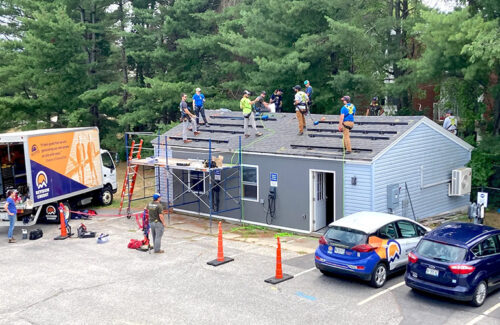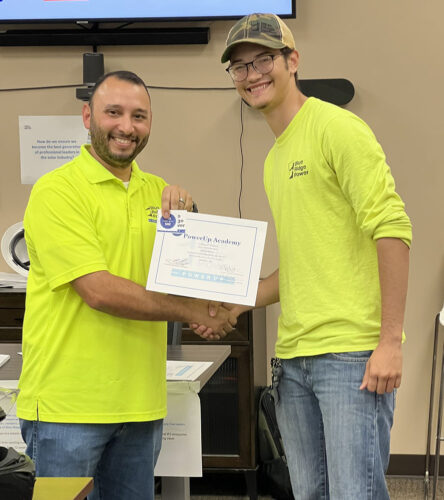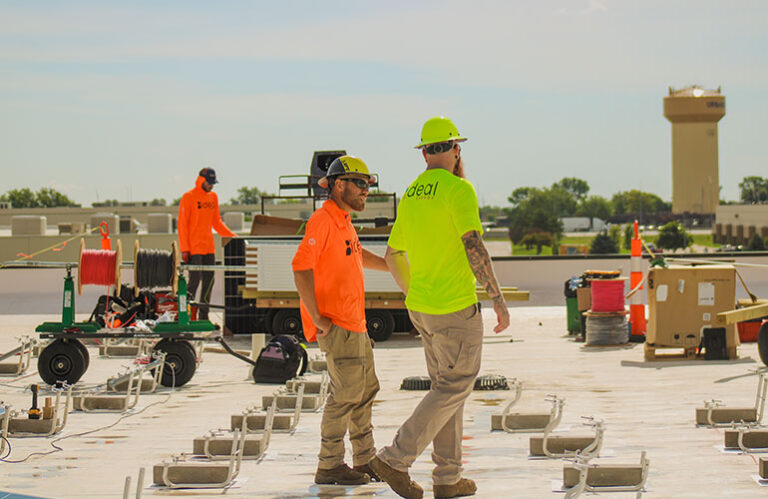
Ideal Energy students are working on a solar project on the roof.
Following the passage of the Inflation Reduction Act (IRA) in 2022, demand for solar apprentices increased significantly. For solar projects 1 MW and larger to qualify for the increased value of the IRA’s tax credits, they must meet certain applicable wage and apprenticeship (PW&A) requirements. Projects that meet PW&A are eligible for a fivefold increased credit.
While the US Treasury Department has released guidance in the field of PW&Ait can be a complex process. Internships in the solar energy sector They are paid on-the-job training opportunities with the goal of qualifying participants as electricians, business engineers and more. There are apprenticeship programs offered across the country by associations and educational institutions designed to cultivate a skilled workforce in the clean energy field.
However, these programs may not be sufficient. Projects must have a sufficient number of journeymen to meet internship ratios, but there is a lack of registered internship opportunities focused on solar energy.
“We can no longer rely solely on existing electrician training programs at community colleges or unions. It is clear that we need a larger, more coordinated effort to provide opportunities to obtain electrical licensing,” said Brie O’Malley, director of ReVision Energy’s Training Center.
A number of solar companies such as ReVision are leading the way in this effort.
Contractor programs that promote apprenticeship development
The ReVision Energy Electrical Apprenticeship Program (REEAP) is a four-year program that provides a combination of paid work experience and online classroom education, prepares students for state licensing exams and qualifies employee-owners for two internship positions with ReVision.
“It’s a program we want to share with other organizations to combat this problem on a larger scale,” O’Malley said.

ReVision Energy students undergo training on a practice roof.
REEAP attracts talent from other countries because it provides paid opportunities for immigrants to obtain their licenses and practice in the United States. O’Malley pointed to a student from Ukraine, Russell Liubychenko, who is “setting a record for how quickly he’s moving through this. Once his hours are over, his talent as an electrician is an asset to any organization.”
Like ReVision, Blue Ridge Power takes a broad view of its potential impact PowerUp Learning Program.
“Our primary objectives extend beyond simple IRA compliance; we are committed to promoting responsible growth within our workforce and giving young people the opportunity to participate in this fast-growing industry,” said Lee Spruill, workforce development program manager at Blue Ridge Power.
Blue Ridge also has a pre-apprenticeship offering for high school students that serves as a stepping stone to the apprenticeship program.
Ideal energy internship program supports aspiring and experienced electrical apprentices through the paid certification process to become electrical journeymen and master electricians. Attention is also paid to employee retention. COO Amy Van Beek said some of the company’s longest-tenured employees came out of the program, pointing to Ideal’s master of record, Brian Robbins – the very first enrolled apprentice.
Best practices for creating an internship program
There are a few ways to ensure a company-run internship program is a success. Recruiting a sufficient number of skilled masters and journeymen adds to the administrative supervision to keep quality high. Participants are more motivated when the program is structured so that they have a financial investment. Clear criteria for participation in the program are also crucial.
“Typically, employees must demonstrate qualities such as reliability and work ethic, mechanical prowess, problem-solving skills, adherence to safety protocols and the ability to perform well in a team,” Ideal’s Van Beek said.

Graduated from Blue Ridge Power’s PowerUp Academy.
Spruill at Blue Ridge said that consulting with experts within the company when developing a program can ensure that the internship criteria matches the skills needed for success. He also recommended working with local education agencies to broaden recruitment efforts and ensure comprehensive training.
Attracting talent is also a challenge. ReVision’s O’Malley suggested emphasizing that the program is a paid option with benefits that provide participants with consistent support from peers and instructors.
“Whether a participant is starting a career or making a career change, knowing they have a group to lean on makes the experience feel more accessible,” she said.
Upon completion of the program, students become co-owners of ReVision and can grow within the company, something that helps potential clients see that the program will have broader implications for their careers.
Ensuring that these apprenticeship programs can prepare workers for jobs even beyond solar energy is another key marker for success.
“These programs should prepare students with the full range of knowledge a certified electrician should have,” O’Malley said. “They should have the opportunity to do all types of electrical work, not just the electrical work required by the company hosting the program.”
Additional barriers to taking advantage of the IRA’s tax benefits
While these contractor-created programs help meet the need for apprenticeships necessary to qualify for IRA benefits, other challenges still remain when it comes to meeting PW&A mandates.
The reporting requirements are quite strict, resulting in additional paperwork, record keeping and contract complexity. Van Beek pointed out that smaller or younger companies without adequate HR departments may struggle to manage the nuanced reporting required.
Laura Cataldo, director of tax firm Baker Tilly’s development advisory practice, explained that many companies do not have experience meeting project requirements set by the Davis-Bacon Act, nor do they understand how IRA mandates differ. This has resulted in “a fundamental lack of understanding of who is covered by prevailing wages and how margins should be calculated and apprentices paid.”
To address these challenges and ensure that clean energy projects earn the additional tax credits, Baker Tilly has created an initiative end-to-end compliance technology solution where users can determine and document PW&A and fines. The compliance portal validates payroll information by connecting to the applicable payroll management system LCP tracker. The system then carries out all compliance testing, catalogs the fines, prepares the administration and communicates with the contractors and the lender.
According to Cataldo, the need for PW&A compliance support will only increase over time as the industry evolves in the wake of recent legislation.
“Staff targets and compliance requirements are becoming increasingly standard in public projects under the Infrastructure Investment and Jobs Act, the CHIPS and Science Act and the IRA, as well as in private projects seeking to achieve ESG objectives,” she said.
Looking to the future of apprentice program growth
Both Ideal Energy and Blue Ridge would like to see legislation that would promote the spread of solar energy training programs. Van Beek said financial incentives going directly to solar companies would expand training for the workforce through apprenticeship programs, including those specifically focused on solar energy technologies.
Spruill said grant funding and guidance services for companies navigating the complexities of PW&A requirements for the first time would also help promote job growth and market expansion.
Regardless of further government support, companies will continue to learn from each other to create successful training programs. Solar energy apprenticeships are a critical tool for both achieving the full IRA tax benefits and building the workforce needed to meet the nation’s increasing demand for solar energy.


